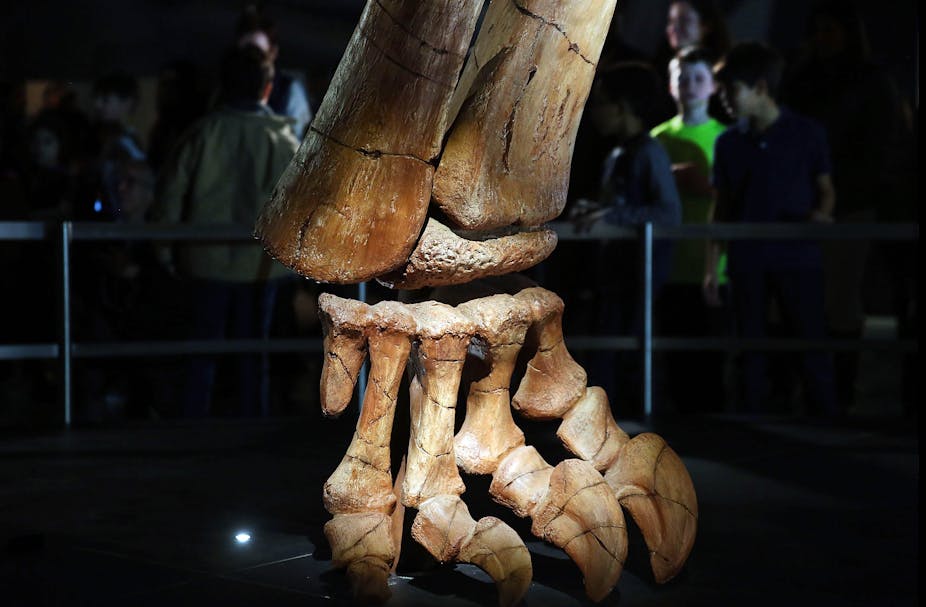You’re probably familiar with classic sauropod dinosaurs – the four-legged herbivores famous for their long necks and tails. Animals such as Brachiosaurus, Apatosaurus and Diplodocus have been standard fixtures in science museums since the 1800s.
With their small brains and enormous bodies, these creatures have long been the poster children for animals destined to go extinct. But recent discoveries have completely rewritten the doomed sauropod narrative.
I study a lesser known group of sauropod dinosaurs – the Titanosauria, or “titanic reptiles.” Instead of going extinct, titanosaurs flourished long after their more famous cousins vanished. Not only were they large and in charge on all seven continents, they held their own amid the newly evolved duck-billed and horned dinosaurs, until an asteroid struck Earth and ended the age of dinosaurs.
The secret to titanosaurs’ remarkable biological success may be how they merged the best of both reptile and mammal characteristics to form a unique way of life.
Moving with the continents
Titanosaurs originated by the Early Cretaceous Period, nearly 126 million years ago, at a time when many of the Earth’s landmasses were much closer together than they are today.
Over the next 75 million to 80 million years, the continents slowly separated, and titanosaurs drifted along with the changing formations, becoming distributed worldwide.
There were nearly 100 species of titanosaurs, making up more than 30% of known sauropod dinosaurs. They varied greatly in size. From the largest known sauropods ever discovered, including Argentinosaurus, Patagotitan and Futalognkosaurus, whose weight exceeded 60 tons (54.4 metric tons) and were bigger than a semitruck, to the smallest known sauropods, including Rinconsaurus, Saltasaurus and Magyarosaurus, which were around only 6 tons (5.4 metric tons) and about the size of an African elephant.
Babies to titans
Like many reptiles, titanosaurs began life comparatively tiny, hatching from eggs no bigger than grapefruits.
The best data on titanosaur nests and eggs comes from a site in Argentina called Auca Mahuevo, featuring 75 million-year-old exposed rocks. The site contains hundreds of fossilized nests containing thousands of eggs, some of which are so well preserved, scientists recovered skin impressions from ancient embryos.

The sheer number of nests found together, in multiple geological layers, suggests titanosaurs returned to this site repeatedly to lay their eggs. The nests are so closely spaced, it’s unlikely an adult titanosaur would have been able to move freely through the nesting ground. Titanosaurs likely had a hands-off parenting style, similar to many reptiles that lay numerous eggs and don’t spend much time tending the nest or taking care of hatchlings.
A titanosaur hatchling would have been roughly 1 foot (30 centimeters) tall, 3 feet (1 meter) long and 5-10 pounds (2.5-5 kg). Recent evidence from a site in Madagascar suggests these tiny titans were born ready to rumble.

Fossilized bones from the species Rapetosaurus suggest that by the time they would have been just knee high to a modern human, they were likely fending for themselves. Microscopic details recorded deep within the bones indicate baby Rapetosaurus likely foraged independently for plants and moved much more nimbly than their lumbering adult relatives.
For the first century of dinosaur science, paleontologists imagined titanosaurs as giant, overgrown reptiles – and used reptilian growth rates to predict their milestones. In this slow-growth model, even the smallest titanosaurs would have taken nearly a century to reach their full size, meaning they would have been relatively small for a good chunk of their lives. New evidence suggests this growth pattern is unlikely.
Scientists like me study titanosaurs’ bones at high magnification to better understand their growth. We look at the microscopic patterns of bone minerals as well as the density and architecture of the spaces that held blood vessels and cells.

The more dense the blood supply is to a bone, the faster that animal grows. These signatures are also present in living animals and can accurately reflect growth rates, anomalies and even age.
Bone data shows titanosaur growth rates were on par with mammals like whales – much, much faster than any living reptile – meaning they would have reached their enormous adult sizes in just a few decades. Scientists can’t know for sure how long titanosaurs lived, but based on large land animals living today, titanosaurs lived possibly 60 or more years.
Fueled by plants
The rapid growth rates of sauropods was partly due to their body temperatures. By studying the chemistry of fossilized teeth and eggshells, scientists have determined titanosaurs had body temperatures ranging from about 95 to 100.5 degrees Fahrenheit (35 to 38 degrees Celsius). That’s higher than that of crocodiles and alligators, about the same as modern mammals and a bit lower than most birds, whose bodies can regularly get as warm as 104 F (40 C).
Titanosaurs’ rapid growth rates were also powered by their prodigious appetites for plants. Microscopic patterns of scratches, wear and pits on their teeth indicate titanosaurs in Argentina fed on a diverse diet rich in grit, suggesting they were dining on plants found lower to the ground, where sediment would be more commonly found.
In India, chunks of fossilized feces, otherwise known as coprolites, show titanosaurs there ingested everything from ground-level plants all the way up to the leaves and branches of trees.
Like all dinosaurs, titanosaurs replaced their teeth throughout life. But data shows they replaced each tooth about every 20 days for maximum efficiency, one of the highest tooth-replacement rates known for dinosaurs.
Had it not been for the asteroid impact 66 million years ago, these long-lived, incredibly diverse and wildly successful animals probably would have kept on thriving, in places as distant as Madagascar, Romania, North America and even Antarctica. Instead, titanosaurs were among the witnesses to – and victims of – the most recent mass extinction on Earth.

